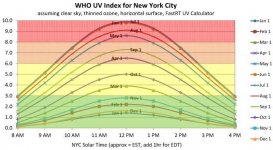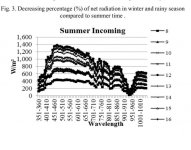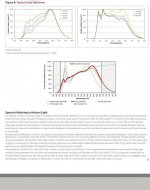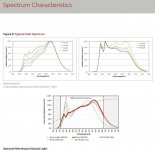The sun's spectrum is the same in all seasons.While these lights are good, but if you intend to duplicate mother nature, seeds are germinated in the spring (cool white light), then as they age, the season/sun changes hue and then again changes hue in the fall cool/cold weather harvest
-
Happy Birthday ICMag! Been 20 years since Gypsy Nirvana created the forum! We are celebrating with a 4/20 Giveaway and by launching a new Patreon tier called "420club". You can read more here.
-
Important notice: ICMag's T.O.U. has been updated. Please review it here. For your convenience, it is also available in the main forum menu, under 'Quick Links"!
You are using an out of date browser. It may not display this or other websites correctly.
You should upgrade or use an alternative browser.
You should upgrade or use an alternative browser.
The best technology of LED lightining at moment 2020
- Thread starter dreadlocos
- Start date
The sun's spectrum is the same in all seasons.
Correct a rainbow has the same colour all year as does looking at sunlight through a prism.
NASA says " Today, the majority of spectral absorption lines have been identified - but not all."
https://science.nasa.gov/suns-spectrum-its-missing-colors
The seasonality of the sun's changing angles relative to a specific position on the earth will indeed change the spectrum observed at that specific position due to Rayleigh scattering and the atmospheric effects being varied across different wavelengths as light travels through the ozone layer.
Oh ya? By how much?The seasonality of the sun's changing angles relative to a specific position on the earth will indeed change the spectrum observed at that specific position due to Rayleigh scattering and the atmospheric effects being varied across different wavelengths as light travels through the ozone layer.
The sun's output does not change colour .The filtered/ refracted light like sunsets etc may change but all thqt is based on atmospheric stuff. The sly is blue regardless of the season. The source colour remains the same.
Shine a white light at a tennis ball, will changing the angle of the flashlight change the color? Intensity of the light in different areas will change on the ball but the color will not change. Still white light just in a different place on the ball.
Shine a white light at a tennis ball, will changing the angle of the flashlight change the color? Intensity of the light in different areas will change on the ball but the color will not change. Still white light just in a different place on the ball.
Oh ya? By how much?
Substantially. Here's an image showing how UV alone changes based on angle of the earth, both throughout the day and also throughout the year in various seasons:
Attachments
So how much? Like say does it go from 6000K to something like 3000? How much does the color change? What's the difference in color at the same time of day in the same place on a clear day, say on the spring equinox and then on summer solstice? Because that's what we're talking about here isn't it?Substantially. Here's an image showing how UV alone changes based on angle of the earth, both throughout the day and also throughout the year in various seasons:
View Image
So how much? Like say does it go from 6000K to something like 3000? How much does the color change? What's the difference in color at the same time of day in the same place on a clear day, say on the spring equinox and then on summer solstice? Because that's what we're talking about here isn't it?
I can't answer that question, but I'd say that it's not a simple linear formula to extrapolate the seasonal change of all the individual wavelengths. In terms of UV specifically, the increase in the amount of UV light that hits the earth on January 1st is increased by about a 7 times on July 1st. I'd definitely call that significant. It seems that shorter waves are more affected by Rayleigh scattering and ozone conditions, compared to longer wavelengths, which seems obvious if you think about it.
Last edited:
SuperBadGrower
Active member
View attachment 551536
View attachment 551537
This is some info i found from a a paper on solar spectrum and intensity variance in Thailand. Im planning on running some laos/thai next year.
Those lines represent hours during summer, rainy and winter days, they don't really compare different times in the year.
This is the graph they use to show the % difference in spectrum between summer and winter (there is also one for monsoon season), a bit easier to see
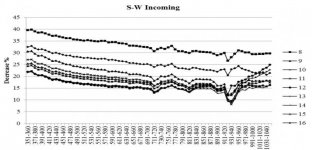
At the wavelength range 351-700nm, the
net radiation decreasing in the winter caused by the station's
location and wind direction which brought particles from the
sea. Especially on sea salt affected the net radiation at the
wave length range 351-700 nm. It showed a good agreement
to [7], [10] which reported that in winter, % decrease was
greater than any other seasons.
In the daytime, the light is more than 75% decrease
in winter compared to the summer, but at the wavelength
range 351-700, winter compared to the summer with more than 75% decrease in comparison
Anyway
 if the sun changed enough throughout the year to matter I think humans wouldn't all agree that 6500 K (100 CRI) (Or what number was it, lol) is "daylight". I'm sure other seasonal cues are stronger and more informative (cold, wetness etc). IMO the authors dont really succeed in explaining the % differences except what I put up there
if the sun changed enough throughout the year to matter I think humans wouldn't all agree that 6500 K (100 CRI) (Or what number was it, lol) is "daylight". I'm sure other seasonal cues are stronger and more informative (cold, wetness etc). IMO the authors dont really succeed in explaining the % differences except what I put up thereNice data, cool paper, but the awful English doesn't help.
edit: I'm not saying life forms that are very sensitive to light won't notice the gradient of change
 ...but I personally am a bit skeptical that this information is useful
...but I personally am a bit skeptical that this information is useful
Last edited:
The change in spectrum is too little to notice, one has to have good measuring tools to find out the ratios stay the same. The intensity falls considerably but that's not spectrum.
Take a look at the curves, there's not even a 3% change. Clouds mean a greater change than seasonal axis tilt.
Cheers
Take a look at the curves, there's not even a 3% change. Clouds mean a greater change than seasonal axis tilt.
Cheers
Okay, so the color of the sun doesn't change then. Even if there is a statistically insignificant change in UV considering that UV isn't even a color.I can't answer that question, but I'd say that it's not a simple linear formula to extrapolate the seasonal change of all the individual wavelengths. In terms of UV specifically, the increase in the amount of UV light that hits the earth on January 1st is increased by about a 7 times on July 1st. I'd definitely call that significant. It seems that shorter waves are more affected by Rayleigh scattering and ozone conditions, compared to longer wavelengths, which seems obvious if you think about it.
Those lines represent hours during summer, rainy and winter days, they don't really compare different times in the year.
This is the graph they use to show the % difference in spectrum between summer and winter (there is also one for monsoon season), a bit easier to see
View attachment 551544
Anywayif the sun changed enough throughout the year to matter I think humans wouldn't all agree that 6500 K (100 CRI) (Or what number was it, lol) is "daylight". I'm sure other seasonal cues are stronger and more informative (cold, wetness etc). IMO the authors dont really succeed in explaining the % differences except what I put up there
Nice data, cool paper, but the awful English doesn't help.
edit: I'm not saying life forms that are very sensitive to light won't notice the gradient of change...but I personally am a bit skeptical that this information is useful
The reason i posted it was to point out there isnt some massive spectrum shift as some have been convinced for some time, myself included. Its there, not as extreme as some assume. Shoot i thought i had left a link to the article as well, anyhow easily googable for those interested.
dreadlocos
New member
You guys totally mess up the first intention of this topic of course we had interesting poit of view here.
But first of all no one are interesting in do exactly replication of sunlight ! thats is impossible.
I just saying that if we can run an system that looks more like sunlight is more adventageus !
There is no comparative at al of 5000k cri 97 vs 3000k cri 80 !
So saying that 3000k is better is pure broscience ! we accepts facts with out the science with out the experimentation !!!!
And yes we have difference in color temperature through the seasons but we dont have in any place 3000k at all !!!! we are talking about 5000k in the summer to 4900k at fall at maximum !!!!
Of corse we have differeces by altitude and sun tilt by different seasons etc but i can say clearly that sunlight spectrum LEDs are 100 times more close to sunlight than those 3000k LED or much worse 1900k HPS say no more !
But first of all no one are interesting in do exactly replication of sunlight ! thats is impossible.
I just saying that if we can run an system that looks more like sunlight is more adventageus !
There is no comparative at al of 5000k cri 97 vs 3000k cri 80 !
So saying that 3000k is better is pure broscience ! we accepts facts with out the science with out the experimentation !!!!
And yes we have difference in color temperature through the seasons but we dont have in any place 3000k at all !!!! we are talking about 5000k in the summer to 4900k at fall at maximum !!!!
Of corse we have differeces by altitude and sun tilt by different seasons etc but i can say clearly that sunlight spectrum LEDs are 100 times more close to sunlight than those 3000k LED or much worse 1900k HPS say no more !
While dread loco hasnt really provided much info, such as manufacture of Cob he was selling, to justify that absurdly overpriced kit listed on ebay. He has a couple valid points. That is a very nice looking spectrum and i would definitely use it. Up until recently leds that dont have that awful 450 peak but offer a more balanced spectrum were prohibitively expensive. Bridgelux put out their new series under the EB series called Thrive. They came up with a formula to compare the spectrum difference of natural sunlight and led. Their 4000k scores best in this series.
As you can see it does not have that 450 peak but plenty of 415-440, and 470+, providing more balance. And this spectrum also has even more deep red than the usual 90cri.
They are in fact very low in lm/w compared to your usual 80 cri. But if im only using it for a small personal grow , whats a few more watts per square ft to make up for loss in efficiency to gain a wicked nice spectrum.
Anyhow these are on the market now. Relatively inexpensive, in cobs and strips. Bridgelux really coming through again.
Atleast for the bridgelux series 4000k thrive is closest to the spectrum listed by dread loco as his 5000k.
For this thrive series the 4000k is the closest to the sun. And if i wanted to obsess over it id add some 410nm mono and maybe some uva, lol. But whose got time for that.
Anyhow , i already bought some 2700 and 4000, 90 cri, well before they released the thrive series. My combo come close to their spectrum, but not as smooth.
Here is some info from the datasheet....


As you can see it does not have that 450 peak but plenty of 415-440, and 470+, providing more balance. And this spectrum also has even more deep red than the usual 90cri.
They are in fact very low in lm/w compared to your usual 80 cri. But if im only using it for a small personal grow , whats a few more watts per square ft to make up for loss in efficiency to gain a wicked nice spectrum.
Anyhow these are on the market now. Relatively inexpensive, in cobs and strips. Bridgelux really coming through again.
Atleast for the bridgelux series 4000k thrive is closest to the spectrum listed by dread loco as his 5000k.
For this thrive series the 4000k is the closest to the sun. And if i wanted to obsess over it id add some 410nm mono and maybe some uva, lol. But whose got time for that.
Anyhow , i already bought some 2700 and 4000, 90 cri, well before they released the thrive series. My combo come close to their spectrum, but not as smooth.
Here is some info from the datasheet....
Attachments
All sounds good but we still need to find out if higher cri makes a noticeable(measurable) difference and if the cost justifies these differences(if they exist).
To some extent I agree with him just not at all regarding the light he is promoting. That price is just LOL.
Cheers
To some extent I agree with him just not at all regarding the light he is promoting. That price is just LOL.
Cheers
dreadlocos
New member
Mind posting some support for your claims or should we accept it as fact and stay silent? Why should your opinion be correct if you can't support it, how could anyone take it seriously?
Buddy is not only me that have no scientific proof of my theory
the common sense that we need to use 3000k because in the fall the sunlight get more reddish in the spectrum in pure nonsense! there is no such thing at all
And i post before one experiment of one guy in other forum that made an experiment of cri 80 and cri 90 cri 90 get ripped 2 weaks early than cri 80 the post was edited by moderation you can find easily on google just serch cri 80vs cr90 and you will se.
beyond than that we have studies that proof that light at 400nm to 440nm improve THC as much as uva light in about 10-20% (i will post this studies late.
beyond than that we have no studies comparing 2 environment with same PPFD (if you know what means) whit sunlike cri97 5000k and 3000k cri80 !.
and the only thing that we have to support that 3000k is better is the nonsensical theory that in the fall the sunlight become 3000k that is the most nonsensical thing ever.
While dread loco hasnt really provided much info, such as manufacture of Cob he was selling, to justify that absurdly overpriced kit listed on ebay. He has a couple valid points. That is a very nice looking spectrum and i would definitely use it. Up until recently leds that dont have that awful 450 peak but offer a more balanced spectrum were prohibitively expensive. Bridgelux put out their new series under the EB series called Thrive. They came up with a formula to compare the spectrum difference of natural sunlight and led. Their 4000k scores best in this series.
As you can see it does not have that 450 peak but plenty of 415-440, and 470+, providing more balance. And this spectrum also has even more deep red than the usual 90cri.
They are in fact very low in lm/w compared to your usual 80 cri. But if im only using it for a small personal grow , whats a few more watts per square ft to make up for loss in efficiency to gain a wicked nice spectrum.
Anyhow these are on the market now. Relatively inexpensive, in cobs and strips. Bridgelux really coming through again.
Atleast for the bridgelux series 4000k thrive is closest to the spectrum listed by dread loco as his 5000k.
For this thrive series the 4000k is the closest to the sun. And if i wanted to obsess over it id add some 410nm mono and maybe some uva, lol. But whose got time for that.
Anyhow , i already bought some 2700 and 4000, 90 cri, well before they released the thrive series. My combo come close to their spectrum, but not as smooth.
Here is some info from the datasheet....
View Image
View Image
My price is a lit bit more high due to the fact as you sayed that LED with high cri are far more expensive than normal LED.
And we can find LEDs with normal spectrum that have the same price as the my one.
The spectrum is that

by the time the only spectrum @ 5000k that have the efficiency of 1.85ppf/w (lumens are irrelevant because the efficacy will change changing the CRI)
In other words cri 100 100lm are more energetic as cri80 100lm
"In other words cri 100 100lm are more energetic as cri80 100lm"
Glad to see we agree. Of course a higher cri is better but how much better and in which way? Does it justify to spend so much more for 5 cri increase? How many more watts will be used over a year for that 5 cri increase?
What exactly means higher cri for phosphor coated blue leds?...
There are many questions on this matter which need answering before making claims as you did in the first post of this thread, still no answers to these questions so there are doubts of course.
If you can't deal with doubts you better not make claims
Anyway, the logic of 3000K and autumn sun and flowering absurd. We use 3000K not because we want to "imitate" autumn but because we know there's a lot of red light which helps produce more bud, simple as that. I have no idea why people still believe such things, looking for absurd connections without explanations, sounds like a mh/hps myth from the old days.
Cheers
Glad to see we agree. Of course a higher cri is better but how much better and in which way? Does it justify to spend so much more for 5 cri increase? How many more watts will be used over a year for that 5 cri increase?
What exactly means higher cri for phosphor coated blue leds?...
There are many questions on this matter which need answering before making claims as you did in the first post of this thread, still no answers to these questions so there are doubts of course.
If you can't deal with doubts you better not make claims
Anyway, the logic of 3000K and autumn sun and flowering absurd. We use 3000K not because we want to "imitate" autumn but because we know there's a lot of red light which helps produce more bud, simple as that. I have no idea why people still believe such things, looking for absurd connections without explanations, sounds like a mh/hps myth from the old days.
Cheers
dreadlocos
New member
"In other words cri 100 100lm are more energetic as cri80 100lm"
Glad to see we agree. Of course a higher cri is better but how much better and in which way? Does it justify to spend so much more for 5 cri increase? How many more watts will be used over a year for that 5 cri increase?
What exactly means higher cri for phosphor coated blue leds?...
There are many questions on this matter which need answering before making claims as you did in the first post of this thread, still no answers to these questions so there are doubts of course.
If you can't deal with doubts you better not make claims
Anyway, the logic of 3000K and autumn sun and flowering absurd. We use 3000K not because we want to "imitate" autumn but because we know there's a lot of red light which helps produce more bud, simple as that. I have no idea why people still believe such things, looking for absurd connections without explanations, sounds like a mh/hps myth from the old days.
Cheers
"Glad to see we agree. Of course a higher cri is better but how much better and in which way? Does it justify to spend so much more for 5 cri increase? How many more watts will be used over a year for that 5 cri increase?"
This dont make too much sense there is no such thing increase in 5 cri point and watts...
because have several technologies and CRI arent as important as the general spectrum.
"Anyway, the logic of 3000K and autumn sun and flowering absurd. We use 3000K not because we want to "imitate" autumn but because we know there's a lot of red light which helps produce more bud, simple as that."
Most of people still say that we need put 3000k because autumn the sun light changes which is a total nonsense
The high CRI LEDs like sunlike spectrum with CRI97 5000k have far more R9 (for those who dont know R9 are the deep red color inside the concept of CRI RE) CRI80 3000k LEDs have an R9 scores far bellow 50 CRI 97 5000k sunlike have an R9 of 93!.
That is the difference in quality between extreme high CRI LEDs and average LEDs inside the CRI all the 14R are above 90
Normal LEDs are around 60 if considering all the R (CRI RE not RA that only measure the firsts 8R.
In other words as the user above you said, extremely high CRI are for those who want quality above everything and aren't want to economize every penny.
CRI 97 sun spectrum are for connoisseur, in an clear example
CRI 97 sunlike have an PPF of 1.85/w
CRI80 lm301h series an PPF of around 2.8/w
But we (people who went really deep in to the studies and have capacity of discernment ) know that PPF even being better measure, comp. with lumens, cannot be said that are as linear as people think.
and im not saying anything but logic, nature yield more quality when we do things more close to the natural and by now those LEDs are the closest to nature possible .
I dont have too much time to be explain our convince any one people who are smart enough will see by itself the value on my studies the other ones not will be worth to bother.
so i will not bother with those who dont have any clues beyond the old paradigm the LEDs are evolving quickly and the market dont absorb yet this quickly evolution special the lasts 5 years
and i say very resumed; people who are looking for quality and dont bother too much to be economizing in every penny will have better result with those technology (I'm saying for the connoisseur )
Commercial dudes that are only focus in yield this are not your interest is better buy lm series or some other big brands of those enslavers company who not even give an shift to their on staff that work in a miserable situation to gain 5cent an hour to an probably snob business man than not even smoke even an joint in their entire life.

